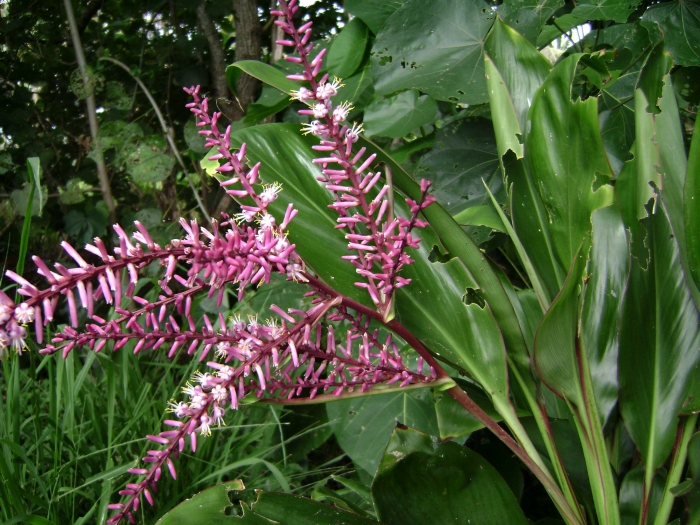Cabbage Tree
(Cordyline fruticosa)
Cabbage Tree (Cordyline fruticosa)
/
/

Tauʻolunga
CC BY-SA 3.0
Image By:
Tauʻolunga
Recorded By:
Copyright:
CC BY-SA 3.0
Copyright Notice:
Photo by: Tauʻolunga | License Type: CC BY-SA 3.0 | License URL: http://creativecommons.org/licenses/by-sa/3.0/ | Uploader: Tauʻolunga | Publisher: Wikimedia Commons | Title: Cordyline_fruticosa,_flowering.jpg |














































































Estimated Native Range
Summary
Cordyline fruticosa, commonly known as Cabbage Tree or Ti Plant, is an evergreen shrub native to tropical rainforests, open woodlands, and scrub areas of Australia, Southeast Asia, and the Western Pacific. It grows 3 to 4 m (9.8 to 13.1 ft) tall, with a slender trunk topped by a fan-like, spirally arranged cluster of broadly elongated leaves that can be green, red, or variegated. The leaves measure 30–60 cm (12–24 in) in length, occasionally reaching 75 cm (30 in), and 5–10 cm (2.0–3.9 in) in width. Cordyline fruticosa produces panicles of small, scented yellowish to red flowers, followed by red berries that are typically dry.
This plant is valued for its striking foliage and is widely used as an ornamental in tropical and subtropical gardens. It can serve as a focal point, be used in container plantings, or as part of a mixed border. The Ti Plant prefers part shade to full shade and requires medium amounts of water, thriving in a range of soil drainage conditions. It is relatively easy to maintain but can be susceptible to root rot if overwatered. Popular cultivars include ’Red Sister’ and ’Belize’, which are chosen for their vibrant leaf colors. While generally pest-resistant, it can occasionally suffer from scale insects or spider mites.CC BY-SA 4.0
This plant is valued for its striking foliage and is widely used as an ornamental in tropical and subtropical gardens. It can serve as a focal point, be used in container plantings, or as part of a mixed border. The Ti Plant prefers part shade to full shade and requires medium amounts of water, thriving in a range of soil drainage conditions. It is relatively easy to maintain but can be susceptible to root rot if overwatered. Popular cultivars include ’Red Sister’ and ’Belize’, which are chosen for their vibrant leaf colors. While generally pest-resistant, it can occasionally suffer from scale insects or spider mites.CC BY-SA 4.0
Plant Description
- Plant Type: Shrub, Tree
- Height: 9-15 feet
- Width: 3-8 feet
- Growth Rate: Moderate
- Flower Color: N/A
- Flowering Season: Spring, Summer
- Leaf Retention: Evergreen
Growth Requirements
- Sun: Part Shade, Full Shade
- Water: Medium
- Drainage: Fast, Medium, Slow
Common Uses
Bee Garden, Bird Garden, Border Plant, Drought Tolerant, Fragrant, Potted Plant, Salt Tolerant
Natural Habitat
Tropical rainforests, open woodlands, and scrub areas of Australia, Southeast Asia, and the Western Pacific
Other Names
Common Names: Good-Luck-Plant , Palm-Lily , Tree-Of-Kings , Ti , Broadleaf Palm-Lily , Tiplant , Keulenlilie , Caña De Indio , Croto , Bloddracena
Scientific Names: Cordyline fruticosa , Cordyline terminalis , Cordyline ti , Cordyline excelsa , Dracaena terminalis , Dracaena moorei , Dracaena ferrea , Taetsia fruticosa , Taetsia terminalis , Dracaena brasiliensis
GBIF Accepted Name: Cordyline fruticosa (L.) A.Chev.